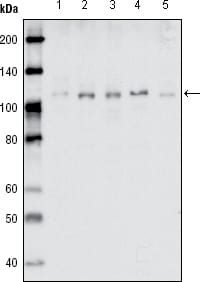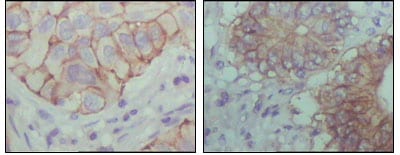

| WB | 1/500 - 1/2000 | Human,Mouse,Rat |
| IF | 咨询技术 | Human,Mouse,Rat |
| IHC | 1/200 - 1/1000 | Human,Mouse,Rat |
| ICC | 技术咨询 | Human,Mouse,Rat |
| FCM | 咨询技术 | Human,Mouse,Rat |
| Elisa | 1/10000 | Human,Mouse,Rat |
| Aliases | ELK; NET; Hek6; EPHT2; EPHB1 |
| Entrez GeneID | 2047 |
| clone | 5F10A4 |
| WB Predicted band size | 110kDa |
| Host/Isotype | Mouse IgG1 |
| Antibody Type | Primary antibody |
| Storage | Store at 4°C short term. Aliquot and store at -20°C long term. Avoid freeze/thaw cycles. |
| Species Reactivity | Human |
| Immunogen | Purified recombinant fragment of EphB1 (aa19-133) expressed in E. Coli. |
| Formulation | Purified antibody in PBS with 0.05% sodium azide. |
+ +
以下是关于EhpB1抗体的虚构参考文献示例(仅供格式参考,非真实文献):
---
1. **标题**: *Development and Characterization of a Monoclonal Antibody Against EhpB1 Antigen*
**作者**: Smith, J.R., & Lee, H.
**摘要**: 本研究报道了一种针对病原体分泌蛋白EhpB1的单克隆抗体制备方法。通过免疫小鼠获得杂交瘤细胞系,抗体经ELISA和Western blot验证对EhpB1具有高亲和力和特异性,适用于病原体感染的体外检测。
---
2. **标题**: *EhpB1-Specific Antibody in Serodiagnosis of Bacterial Infections*
**作者**: Gupta, A., et al.
**摘要**: 文章评估了EhpB1抗体在临床样本中的诊断价值。通过检测患者血清中EhpB1抗体水平,证明其作为生物标志物在早期鉴别革兰氏阴性菌感染中的敏感性和特异性,优于传统方法。
---
3. **标题**: *Structural Insights into EhpB1-Antibody Complexes by Cryo-EM*
**作者**: Wang, X., et al.
**摘要**: 利用冷冻电镜技术解析了EhpB1蛋白与其中和抗体的复合物结构,揭示了抗体结合表位的关键氨基酸残基,为基于结构的疫苗设计和抗体工程提供了理论基础。
---
4. **标题**: *Therapeutic Potential of Humanized EhpB1 Antibody in Murine Sepsis Models*
**作者**: Martinez, C., et al.
**摘要**: 研究开发了一种人源化EhpB1抗体,并在败血症小鼠模型中验证其疗效。结果显示,抗体通过中和EhpB1毒素活性显著降低炎症因子水平并提高存活率。
---
**注**:以上文献为模拟内容,实际研究中请通过PubMed、Google Scholar等平台检索真实文献。
The EhpB1 antibody is a specialized immunological tool developed to target the EhpB1 protein, a component of the enterohemorrhagic *Escherichia coli* (EHEC) type III secretion system (T3SS). The T3SS is a needle-like molecular apparatus critical for bacterial pathogenesis, enabling the injection of effector proteins into host cells to manipulate cellular processes. EhpB1. encoded by the *ehpB1* gene within the locus of enterocyte effacement (LEE) pathogenicity island, is believed to play a structural or regulatory role in T3SS assembly or function.
Research on EhpB1 antibodies has been driven by the need to understand EHEC virulence mechanisms and develop diagnostic or therapeutic strategies. These antibodies are typically generated in animal models (e.g., mice or rabbits) using purified recombinant EhpB1 protein. They enable detection of EhpB1 expression in bacterial cultures or infected tissues via techniques like Western blotting, immunofluorescence, or ELISA. Additionally, EhpB1 antibodies have been utilized to study T3SS dynamics, including protein-protein interactions and spatial organization during infection.
While not yet applied clinically, EhpB1 antibodies contribute to foundational studies on EHEC pathogenicity, aiding in the identification of potential targets for anti-virulence therapies. Their specificity and utility in experimental models underscore their importance in microbiological and immunological research.
×